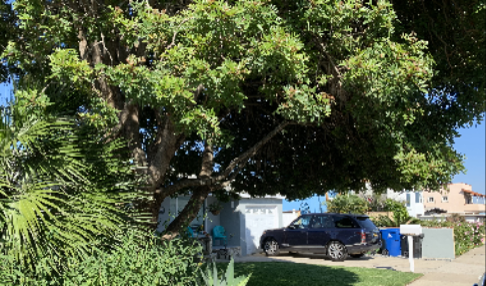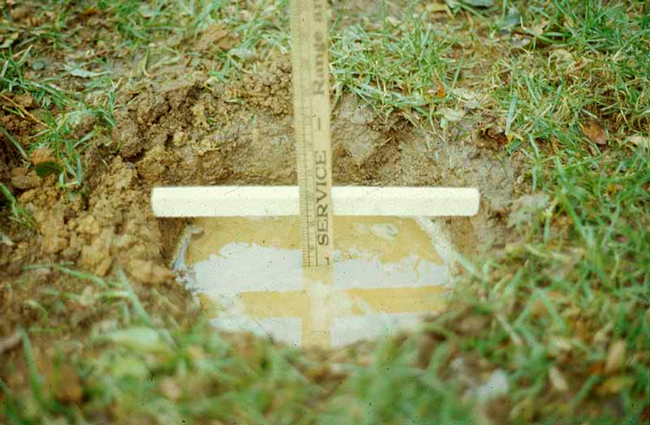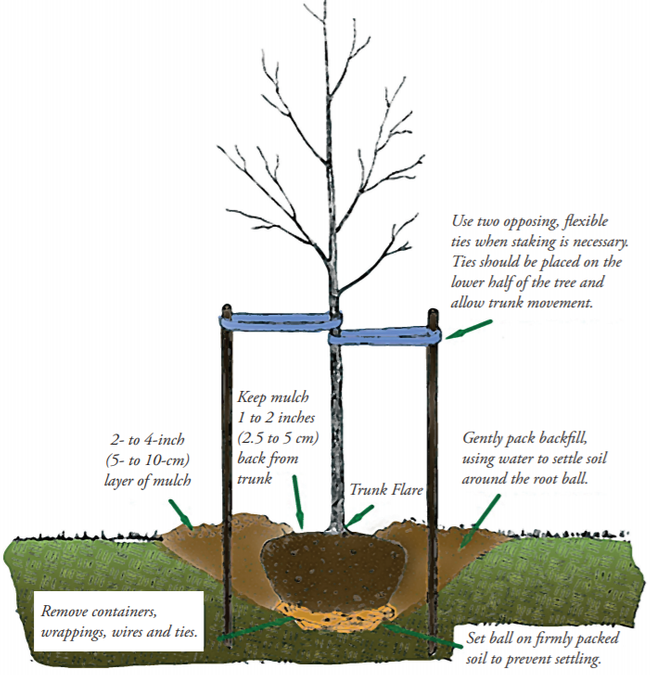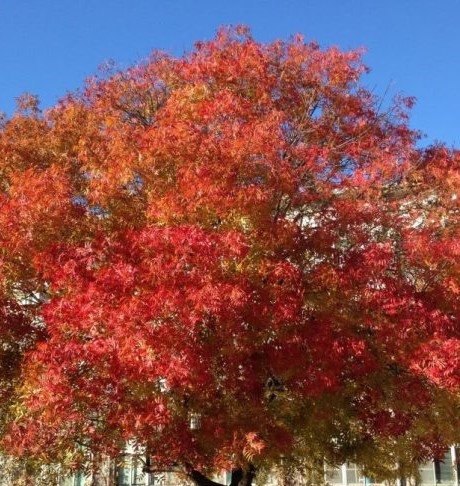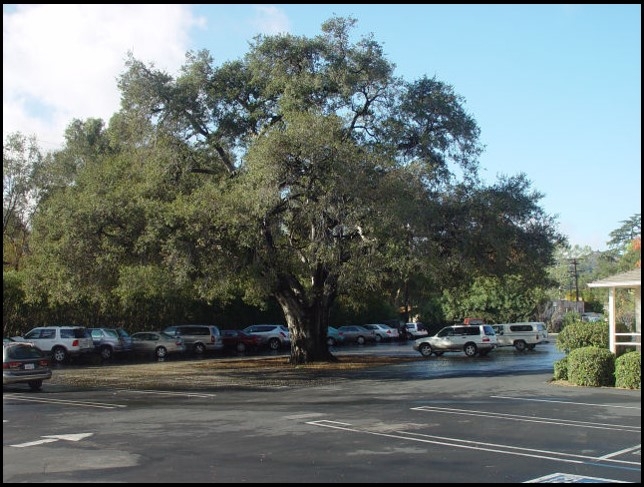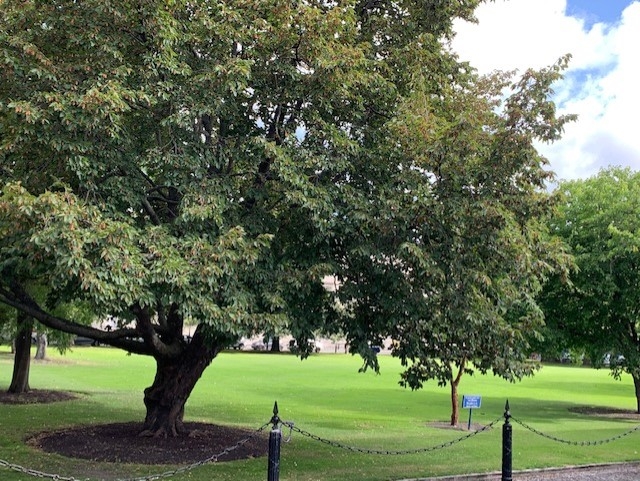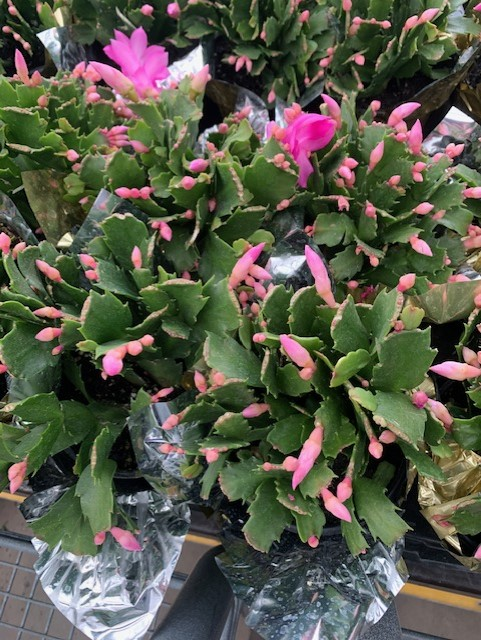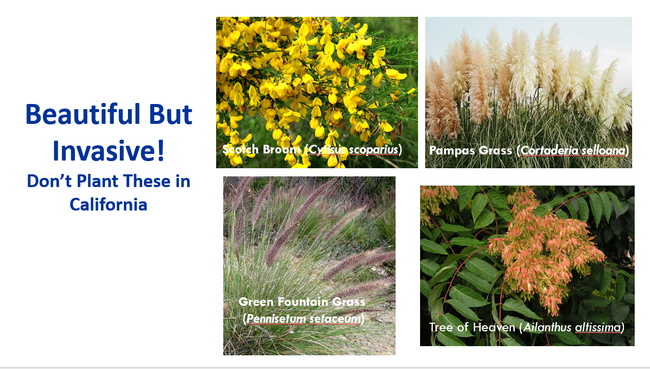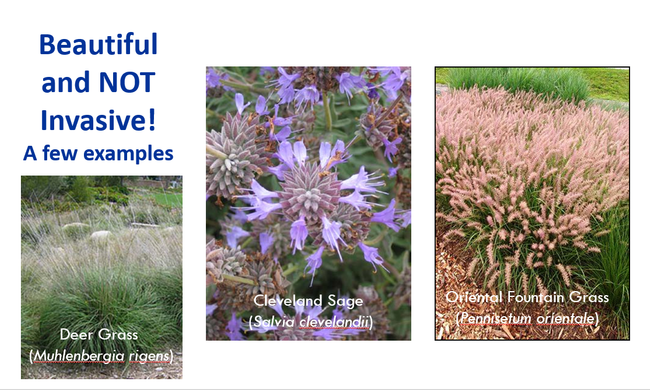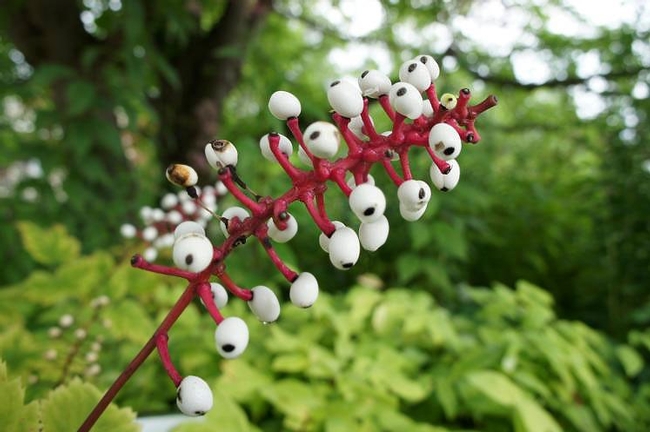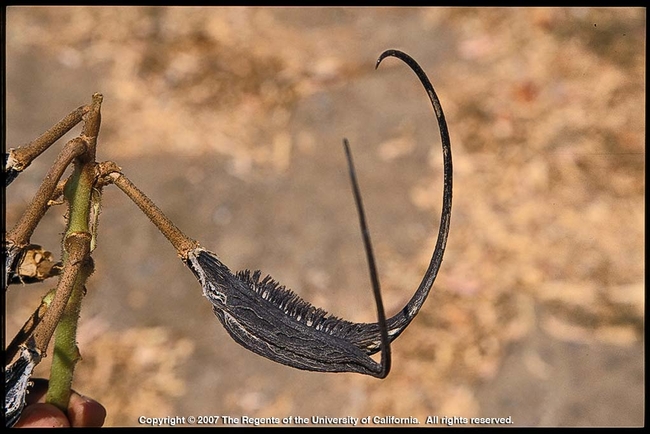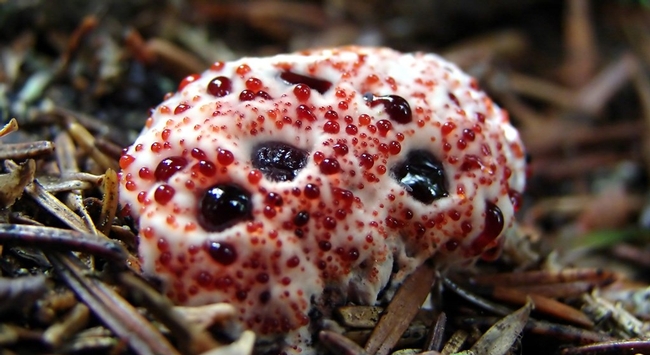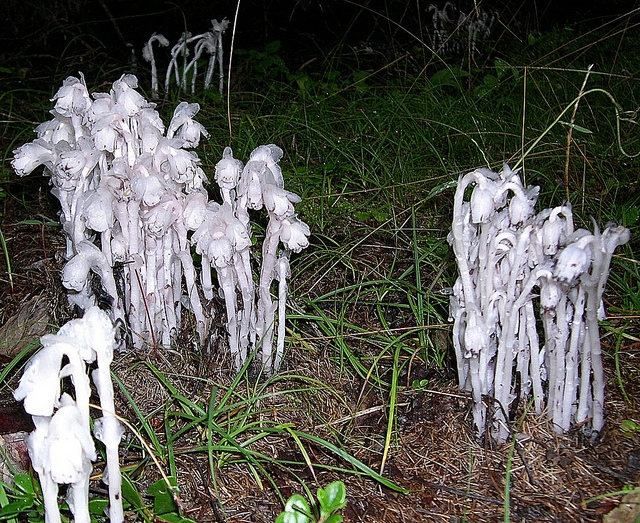Posts Tagged: Hartin
Plant a Tree. Leave a Legacy!
Do you have Spring Fever? If you have adequate space, why not leave a legacy to your children's children by planting a tree? When the right species is planted in the right location with the right care, landscape trees can be enjoyed for 100 years or more. Landscape trees cool urban heat islands, absorb carbon dioxide, filter toxic chemicals from soil preventing them from polluting our waterways, reduce soil and water erosion, reduce internal energy needs and related costs, provide habitat, and beautify neighborhoods.
Spring is a much better times to plant a container landscape tree in California than is summer. Trees incur far less stress if they've been in the ground several weeks rather than having to immediately adapt to high summer temperatures. Cooler weather allows plants to establish roots in their new ‘home' before the harshness of summer sets in. (Deciduous bare-root fruit trees, on the other hand, should be planted during the winter when they are dormant.) Choose recommended species for your climate and micro-climate.
Choose trees based on your Sunset climate zone (more precise than USDA zones for California since they include impacts of high temperatures as well as low temperatures) and your microclimate (shade, soil conditions, space, etc.). Four of my favorite search engines that allow one to search by multiple criteria (size, water needs, flower color, ecosystem functions, pest susceptibility, etc.) are: Inland Valley Garden Planner: https://inlandvalleygardenplanner.org/; Cal Poly, Pomona: https://selectree.calpoly.edu;California Native Plant Society: http://www.cnps.org/cnps/grownative/lists.php; and WUCOLS IV (Water Use Classification of Landscape Species): http://ucanr.edu/sites/WUCOLS
Avoid circled, girdled roots. Remember to inspect the root system of container trees. Avoid purchasing specimens with severely circled and girdled roots. Root pruning will not solve the problem and the resulting tree is much more prone to failure later. This occurs because the upper portion of the tree continues to grow and expand while the root system lacks the breadth and architectural strength to support the tree. Many times a tree will look fine for several years and - seemingly - very suddenly topple in winds that otherwise it could sustain with a more adequate root system. Only when the tree falls does the owner actually notice firsthand that the root system is the same size it was when the tree was planted years before!
Check drainage before you plant. Dig a hole where you are planning on planting the tree, fill it with water, and make sure it completely drains within 24-hours. If it doesn't drain, don't plant a tree there. In some cases, trees are carefully selected based on species and location only to perish ten or more years later due to poor drainage and water-logged soil. Trees often die in these situations due to a lack of aeration setting them up for disease-causing fungal pathogens.
Planting the tree. Dig a hole at least 2-1/2 times the width of the container (in clay or compacted soils make the hole at least 4-5 times wider) up to two inches shallower than the depth of the tree in the container to compensate for settling. Use a shovel or trowel to roughen the soil on the sides of the hole to encourage root growth into the native soil. Remove the tree from the container along with any loose soil that covers the lower part of the trunk. Carefully place the tree in the planting hole, keeping the trunk flare (the area where the trunk widens and connects with the roots) 1-2 inches above the existing grade. Gently fill the hole with the same soil that was removed. Do not add soil amendments or compost, another common cause of circled and kinked roots. Irrigate the tree immediately after planting through the entire root system and slightly deeper. Keep in mind that soils with appreciable clay content absorb water more slowly than sandier soils and need to be watered longer but less often. Water newly planted container trees often through their establishment period, even if they are drought tolerant species. Recently transplanted trees have a small volume of roots that dry out very quickly. Water newly planted trees regularly through the first season. Trees in sandy soils require more frequent watering than do trees in heavier soils. (After trees are fully established, irrigation frequency should be reduced but more water should be added during each irrigation.)
Avoid staking trees unless necessary. Stake trees only if they were staked at the nursery and/or if they are planted in a wind-prone area. Remember to loosen ties on nursery stock before they girdle the trunk. Gently secure any tree requiring staking with two opposing flexible ties on the lower half of the tree, allowing the tree to gently blow in the wind to encourage lower trunk strength. Avoids taking trees tightly, restricting flex. As the tree matures, remember to loosen ties and aim for removing stakes entirely if the tree is self-supporting.
Pruning. Avoid heavy pruning at the time of planting. Remove only broken branches, crossed branches and suckers at the base of the tree.
Fertilizing. Most trees have received adequate nutrition in the nursery and do not need fertilizer at the time of planting.
Mulching. Apply a 2-4 inch layer of mulch three or more inches away from the tree trunk. Organic mulches such as woodchips and compost should be applied and maintained at a depth of 3-4 inches to prevent weed seeds from sprouting. Inorganic mulches (gravel, pebbles, etc.) should be maintained at 2-3 inches. In fire-prone areas, organic mulches near the urban/forest interface should be avoided. Remember to irrigate below the mulch.
For more information on tree planting and care and all other home gardening and landscape topics, contact the UCCE San Bernardino County Master Gardener Helpline at mgsanbern@ucanr.edu
Be part of the solution: Plant drought, heat, and pest resistant trees to combat urban heat islands
Our population of urban trees is shrinking! You can help turn this around by protecting your own trees and by planting new ones recommended for your climate and the conditions around your home. For more on this topic, please revisit my February blog for specific selection and care recommendations: https://ucanr.edu/b/~ZuB.
In addition, please encourage your city to plant a wide range of recommended species today for a healthier tomorrow. Why is this so important? Many of our current street trees are in the 11th hour of their lifespans. While some that were planted decades ago are simply aging naturally, in other cases, they are perishing prematurely due to poor selection and care. This leads to a downward spiral; trees not adapted to the climate they're planted in and not receiving proper care are much more susceptible to invasive pests (shot-hole borers, etc.) and diseases than are healthy, well- chosen and maintained trees. Even the loss of one front yard shade tree can significantly reduce shade, increase the surrounding temperature, and diminish energy savings.
Another reason we're losing our trees is due to the negative impacts of urban heat islands (UHIs) which shorten the lifespan of many species of trees dramatically. Some trees (even many natives!) just aren't able to withstand the higher temperatures (sometimes exceeding 20 degrees) they are subjected to due to UHIs.
What are urban heat islands and why should we care? Urban heat islands are caused by reradiated heat from paved concrete and (especially) asphalt surfaces.
Hard surfaces of UHIs absorb large amounts of heat generated during the day and release it at night, slowly but steadily warming average nighttime (mostly) and daytime temperatures. Together, these negative impacts on our urban trees lead to a sad reality: the average lifespan of an urban tree is only about ¼ of its potential. While our stately shade-producing ficus, oak, maple, pine, rosewood and magnolia trees have potential lifespans of 80 -120 years or longer in unstressed environments, most perish much sooner.And, our cities are growing and expanding. Very few Southern California residents reside in rural areas. Instead of living near pastures, field-filled crops, and forests that cool the surrounding area through evapotranspiration, the vast majority of us reside in warmer urban city centers. Conditions we expect our city trees to endure in 2021 are very different from even 20 to 30 years alone, let alone decades ago.
The good news is that, through proper tree selection and care, we can be a part of the solution. In fact, trees offer many benefits that offset the impacts of UHIs. Cities with larger tree canopies are a testament to this fact and have fewer adverse impacts from UHIs than do cities with low tree canopies. Trees reduce the impact of UHIs by shading parking lots, buildings, and vehicles), deflecting the sun's radiation, and cooling the atmosphere through evapotranspiration. Trees also absorb and store carbon which lessens the impacts of pollution from fossil fuels. A well-tended mature landscape tree can absorb 40 tons of carbon over its lifespan.
The solution? Augment our current urban tree palettes with heat, drought, and pest-resistant native and adapted non-native species. A case in point of a native tree in trouble is our beautiful Joshua trees (Yucca brevifolia) which are dying off in their namesake National Park and seeding 500 or more feet higher elevation than parent plants. Planting trees that withstand UHIs today is crucial for tomorrow.
We are well on the way to identifying landscape tree species that can remain healthy under adverse urban conditions. In our study examining the performance of 12 species of underplanted but promising landscape trees, several candidates are standing out for their heat, drought, and pest resistance.
Thanksgiving or Christmas cactus? Are they the same species?
With only a few short weeks between Thanksgiving and Christmas and two very similarly looking plants, you may be wondering whether the gift a loved one gave you for Christmas is a Thanksgiving cactus or a Christmas cactus. (Many sold in local nurseries and large box stores this past Christmas season were actually Thanksgiving cactus (S. truncata), pictured below). While both are native to tropical regions of Brazil, host a wide array of flowers ranging from the more traditional pink hues to newer hybrids showing off white, red, yellow, and purple, they have different bloom periods. The Christmas cactus (Schlumbergera bridgesii), blooms about a month after the Thanksgiving cactus.
The Christmas cactus also has slightly different projections on its leaves, which are more scalloped and less pointed that the projections on the Thanksgiving cactus. Is yours still not in flower and not in the holiday spirit? Both species require cool temperatures and longer nights for about a month in advance of their flowering period. Both plants bloom optimally when grown outdoors when cool night temperatures dip`into the 50s and shorter nights reduce daytime light to 10 -12 hours in a 24 hour cycle. They can also be grown indoors in pots if kept in a cool dark area with no light between 5 pm and 8 am. During daytime, they prefer bright, indirect light. Full sun can cause the leaf segments to turn dark red. Both species require good drainage but, even though they are in the cactus family don't let this fool you! They need adequate moisture - particularly during boom- and cannot make it through long, dry periods without supplemental water. Unlike most houseplants, they prefer to feel snug in their pots, almost to the point of enjoying being slightly pot-bound.
Happiest of holidays however you choose to safely celebrate them this year!
Janet
Invasive Plants: Don't Encourage 'Bad Neighbors'
What do ice cream, potato chips, Scotch and Spanish Broom, and Tree of Heaven have in common? While they're all tempting to indulge in, less is more. In fact, plants such as Scotch, Spanish Broom, Tree of Heaven, Pampas Grass, Green Fountain Grass, and dozens of plants are all considered invasive plants in California. Simply put, they should not be planted. There are some great alternative plants that are better choices listed at the end of this blog.
Truth be told, I admit to falling madly in love with the Spanish Broom (Spartium junceum) shrubs adorning Highway 18 on my drive from San Bernardino to Lake Arrowhead in early spring 1984 right after my job interview for my current position. Being a “wet behind the ears” recently hatched graduate student from the Midwest I was truly in awe of their lovely yellow blooms and vowed to plant one if I got the chance to move to California. Fortunately, I found out very soon that, while the plantings were made on purpose, they were a mistake and needed to be removed due to their invasive nature.
While they were ‘recruited' from Europe and had what seemed like a perfect resumé (fast growth, lovely yellow flowers, adaptability to poor infertile soil and disease and insect-resistance), they didn't play well with others, a fatal flaw. In California, they were aggressive and crowded out native plantings. Fires only exacerbated the situation. After the 2003 burns, the Spanish Broom populations exploded, obliterating any remaining natives and taking an even larger area hostage. In summer 2010, the San Bernardino National Forest removed the plants in a costly but necessary $500,000 project under a partnership with the American Recovery and Reinvestment Act. Constant monitoring continues in the San Bernardino Mountains and other areas of the state to prevent its reestablishment which is challenging due to its ability to quickly resprout, seed longevity, and effective dispersal. It has definitely earned its ‘noxious weed' label!
This is just one example of the problems posed by invasive plants. In effect, they grow too well! They outcompete desirable plants in our gardens, lawns, and other urban and natural areas for water, nutrients, and space. They also shade sun-requiring plants. Threatened and endangered plant species and other California native plants are particularly vulnerable to their encroachment. (In most cases, invasive plants are non-native species.) Interestingly, our beloved state flower, the California poppy, is an invasive plant in New Zealand, Hawaii and other locations outside of California.
As urban gardeners, we can all greatly reduce the impact of the encroachment of invasive plants in our urban environments. Please don't plant invasive sane remove plantings on your property to stop their spread. Below are some great resources to learn more about invasive plants and find viable replacements:
California Invasive Plant Council: https://www.cal-ipc.org/
Don't Plant a Pest: https://www.cal-ipc.org/solutions/prevention/landscaping/dpp/
Invasive Plants of Southern California:https://www.cal-ipc.org/solutions/prevention/landscaping/dpp/?region=socal
PlantRight: https://plantright.org/about-invasive-plants/plant
Halloween Plants that will Scare the BOO out of you!
It's a scary time of year! Plants are amazing life forms, coming in a wide array of forms, shapes, and colors. Here are some of my favorite Halloween plants that are sure to scare the living daylights out of you!
Doll's Eyes (Actaea pachypoda)
Devil's Claw or Ram's Horn (Proboscidea louisianica)
This unfriendly looking species is native to the South Central USA and sports a unique horn-shaped pod. In addition to its attention-grabbing visual appeal, pigments contained in the pod are used for black dyes by several Native American tribes.
Bleeding Tooth Fungus (Hydellum peckii)
White Ghosts or Indian Pipes (Monotropa uniflora)
These eye-catching specimens have bright white droopy flowers reminiscent of ghosts found in spooky dark, dank basements. They hide in shady spots and live in a symbiotic relationship with a fungus in their roots providing food.
Happy Fall!
Janet





